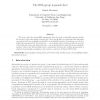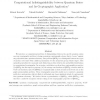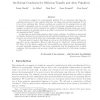112
Voted
EUROCRYPT
2005
Springer
15 years 6 months ago
2005
Springer
Abstract. MD5 is one of the most widely used cryptographic hash functions nowadays. It was designed in 1992 as an improvement of MD4, and its security was widely studied since then...
EUROCRYPT
2005
Springer
15 years 6 months ago
2005
Springer
MD4 is a hash function developed by Rivest in 1990. It serves as the basis for most of the dedicated hash functions such as MD5, SHAx, RIPEMD, and HAVAL. In 1996, Dobbertin showed ...
100
click to vote
EUROCRYPT
2005
Springer
15 years 6 months ago
2005
Springer
We introduce a new type of Identity-Based Encryption (IBE) scheme that we call Fuzzy Identity-Based Encryption. In Fuzzy IBE we view an identity as set of descriptive attributes. ...
124
click to vote
EUROCRYPT
2005
Springer
15 years 6 months ago
2005
Springer
We prove, under the strong RSA assumption, that the group of invertible integers modulo the product of two safe primes is pseudo-free. More specifically, no polynomial time algor...
102
Voted
EUROCRYPT
2005
Springer
15 years 6 months ago
2005
Springer
The Lenstra-Lenstra-Lov´asz lattice basis reduction algorithm (LLL or L3 ) is a very popular tool in public-key cryptanalysis and in many other fields. Given an integer d-dimensi...
109
Voted
EUROCRYPT
2005
Springer
15 years 6 months ago
2005
Springer
In this paper we analyze the statistical distribution of the keystream generator used by the stream ciphers RC4 and RC4A. Our first result is the discovery of statistical biases o...
104
click to vote
EUROCRYPT
2005
Springer
15 years 6 months ago
2005
Springer
In undeniable signature schemes, zero-knowledgeness and non-transferability have been identified so far. In this paper, by separating these two notions, we show the first 3-move ...
118
Voted
EUROCRYPT
2005
Springer
15 years 6 months ago
2005
Springer
We introduce a computational problem of distinguishing between two specific quantum states as a new cryptographic problem to design a quantum cryptographic scheme that is “secu...
101
Voted
EUROCRYPT
2005
Springer
15 years 6 months ago
2005
Springer
We present a general framework for constructing two-message oblivious transfer protocols using a modification of Cramer and Shoup’s notion of smooth projective hashing (2002). ...
111
click to vote
EUROCRYPT
2005
Springer
15 years 6 months ago
2005
Springer
A (1,2)-robust combiner for a cryptographic primitive P is a construction that takes two candidate schemes for P and combines them into one scheme that securely implement P even i...



